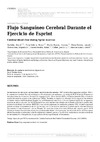Identificador persistente para citar o vincular este elemento:
https://accedacris.ulpgc.es/handle/10553/58145
| Title: | Flujo sanguíneo cerebral durante el ejercicio de esprint | Other Titles: | Cerebral Blood Flow During Sprint Exercise | Authors: | Curtelin, David Perez Valera, Mario Martin Rincon, Marcos Cherouveim, Evgenia D. Torres Peralta, Rafael Calbet, José A. L. Morales Alamo, David |
UNESCO Clasification: | 241106 Fisiología del ejercicio | Keywords: | Flujo sanguíneo cerebral Alta intensidad |
Issue Date: | 2016 | Journal: | Kronos | Abstract: | Se desconocen los efectos del entrenamiento interválico de alta intesidad (HIIT) sobre el flujo sanguíneo cerebral (FSC) y la oxigenación cerebral. Por ello reclutamos a 20 voluntarios que realizaron una sesión de HIIT (4 test de Wingate con recuperaciones de 4 minutos). Se midió la oxigenación del lóbulo frontal (OLF) y el Vastus lateralis (VL) a través de espectrofotometría cercana a los infrarrojos (NIRS). También se registró la velocidad de la sangre en las arterias cerebrales medias (vACM) mediante Doppler. La vACM disminuyó entre un 5 y 10 % en el primer esprint. En los siguientes esprints se redujo aún más. La vACM descendió en cada esprint coincidiendo con la disminución de la presión tele-espiratoria de dióxido de carbono (PETCO2) y con valores superiores de ventilación pulmonar (VE). Al interrumpirse el pedaleo se redujo bruscamente la vACM. Sin embargo, la OLF se mantuvo estable en el primer esprint sólo reduciéndose ligeramente durante el segundo y tercer Wingate (el cuarto fue similar al tercero). Este estudio muestra que la vACM disminuye durante los ejercicios de esprint, posiblemente debido a la hipocapnia. La reducción de la vACM no ejerce efectos funcionales ni relevantes sobre la oxigenación cerebral, gracias al ajuste de la conductancia vascular a través de los mecanismos de autoregulación, sin que parezca afectar negativamente al rendimiento. The effect of high-intensity interval training (HIIT) on cerebral blood flow (CBF) and cerebral oxygenation remain unknown. Therefore, we recruited 20 voluntaries who performed one HIIT session (4x30s Wingate tests with 4 minutes recovery between them). We measured frontal lobe (FLO) and Vastus lateralis (VL) oxygenation with NIRS. Middle cerebral artery blood flow velocity (MCAv) was measured by Doppler. MCAv decreased between 5 and 10 % during the first sprint. MCAv decreased slightly more during the subsequent sprints. Nevertheless, FLO remained stable during the first sprint and was only reduced slightly during the second and third Wingate (the fourth was similar to the third). MCAv decreased on each sprint with the reduction of End-tidal carbon dioxide pressure (PETCO2), the latter due to hyperventilation. When subjects stopped pedaling MCAv was dropped markedly. The decrease in MCAv did not produce any functional or relevant effect on frontal lobe oxygenation due to the adjustment of cerebral vascular conductance by the auto-regulatory mechanisms and did not seem to negatively affect performance. |
URI: | https://accedacris.ulpgc.es/handle/10553/58145 | ISSN: | 1579-5225 | Source: | Kronos [ISSN 1579-5225], v. 15 (2), p. 6-0 | URL: | http://dialnet.unirioja.es/servlet/articulo?codigo=5787992 |
| Appears in Collections: | Artículos |
Page view(s)
389
checked on Nov 1, 2024
Download(s)
697
checked on Nov 1, 2024
Google ScholarTM
Check
Share
Export metadata
Items in accedaCRIS are protected by copyright, with all rights reserved, unless otherwise indicated.
